The relief by the door is a 70th birthday present to Sibelius from the sculptor Wäinö Aaltonen (1894-1966). Most of the wall is covered by a sleigh rug. The year 1841 is woven into it, referring to the year when Sibelius's mother was born. However, judging by a letter by the composer's childhood friend Walter von Konow, the rug was completed in 1904.
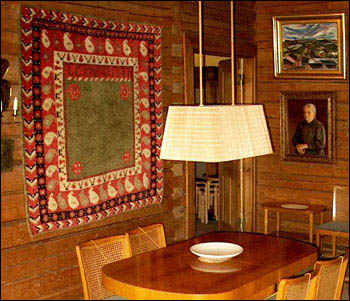
The wall to the right of the vestibule door is covered with paintings. On the top left there is a landscape in oils by Tyko Sallinen (1879-1955) dating from 1914; this was a 50th birthday present for Sibelius. Under that there is a portrait of Aino Sibelius's mother, Elisabeth Järnefelt. It is a copy by Laura Järnefelt (1904-1985) of a painting by her father, Eero (the original is at Suviranta). To the right of these there are three works: at the top a landscape by Uuno Alanko (Uno Alanco, 1878-1964), a 50th birthday present for the composer. Below it there is "A Cloudy Day" by Wilho Sjöström (1873-1944). Below these there is a painting which always put Sibelius in a happy mood, the warmly toned "Courtyard Sauna" by Kaspar Järnefelt (1859-1941).
The two paintings after this were made by people in Sibelius's immediate circle. The upper painting is "A Spanish Woman" by Sibelius's nephew, Christian Sibelius (1910-1951) The lower one is "An Old Well" by Pekka Halonen (1865-1933). Sibelius is reported to have bought this painting for a hundred marks in order to ease his friend's financial difficulties. The painting was bought sometime between the years 1904 and 1915; thus the monetary value of the composer's neighbourly help was 235-350 euros, depending on the year of purchase.
To the right of the works mentioned above there is a pastel, "On Sarvikallio Rock", by Eero Järnefelt, dating from 1919. Sarvikallio is near Syväranta, opposite the present museum of the Lotta Svärd organisation, on the other side of Lake Tuusula. The artists' families used to go there for picnics.
Next to the congratulatory lyre given by the choir Muntra Musikanter,
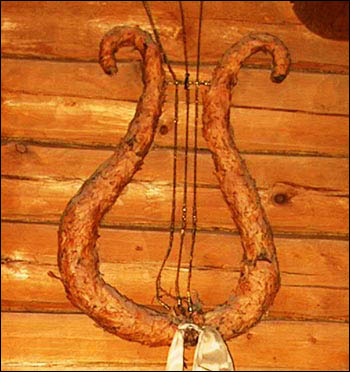
at the lintel of the opening to the entrance hall, we can see one of the two works by Oscar Parviainen (1880-1938) that are on display at Ainola. This one is called the "The Cortège" and it was Sibelius's favourite painting.
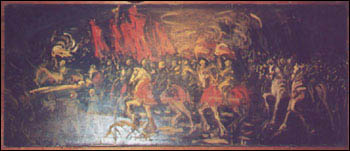
Parviainen was inspired to paint "The Cortège" after hearing Sibelius play his funeral march theme in Paris (January 1906). On the same occasion Sibelius also played A Prayer to God, which was the inspiration behind Parviainen's painting of the same name. This latter painting is now behind the grand piano at Ainola.
Most probably, the funeral procession theme was connected with the second part of the oratorio Marjatta, within which the librettist Jalmari Finne had asked for a funeral march sequence. According to the text, the infant Jesus was carried "late at night hidden in spring rain" to be buried in a dark forest, "under a budding spruce-tree".
Parviainen made several versions of the subject. Sibelius received this sketch in October 1908. After they had met in Paris, Parviainen had spent the winter in Madrid. There, the subject acquired various medieval characteristics. In addition, the influence of Velázques is obvious. Sibelius's letter of thanks to Parviainen betrays admiration and confusion:
"Now, how could I thank you for your magnificent present? I recognise the ideas you had in Paris, although they have undergone considerable development. As a layman I can only describe the impact of your works on me; this has been very special and profound."Sibelius ignored Parviainen's remarks of "red-red and black-black" and called the work a "painting in D major". He considered D major to be equivalent to the colour yellow. Parviainen had used yellow for the flare of the torches, reflected from the horses and the coffin. About twenty years earlier Sibelius had told his friend Adolf Paul that he should be buried in a yellow coffin.
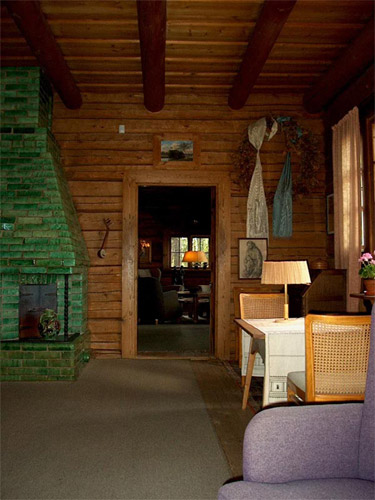
On the left side of the library door there is a small African stringed instrument. This was given to Sibelius in 1925 by his friend Erik O. W. Ehrström (1881-1934). Above the door there is an early landscape by Eero Järnefelt (1863-1937) dating from the end of the 1880s. On the right side of the door there is one of three works by Axel Gallén (1865-1931) dating from the year 1894, a charcoal of a person listening to a waterfall. The wall above this has a congratulatory wreath from the Finnish people to the 85-year-old composer. On the wall to the right of the wreath there is a charcoal drawing of a tree. This was drawn by the composer's nephew Christian Sibelius (1910-1951) in 1939.On the shelves under the wall clock there is a photograph of Aino's mother Elisabeth, plus several sculptures and other works of art, including the presents for Sibelius's 50th birthday given by the sculptors Ville Vallgren (1855-1940) and Emil Wikström (1864-1942).
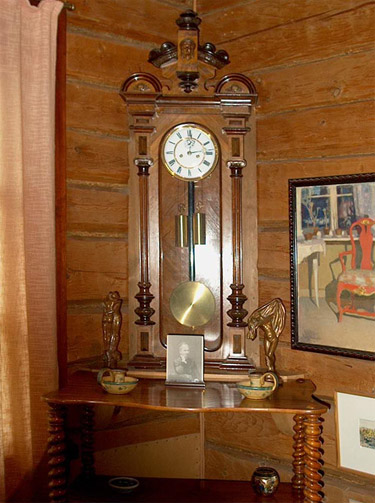
Above the photo (which is probably of Sibelius's hand holding a lighted cigar), to the right of the shelves, there is a small landscape watercolour by Sibelius's nephew Juhana Blomstedt (b. 1937) and above it a 50th birthday present from Eero Järnefelt (1863-1937): a painting of a red chair in front of a window. The chair in question is still in Suviranta, but today its colour is grey.

